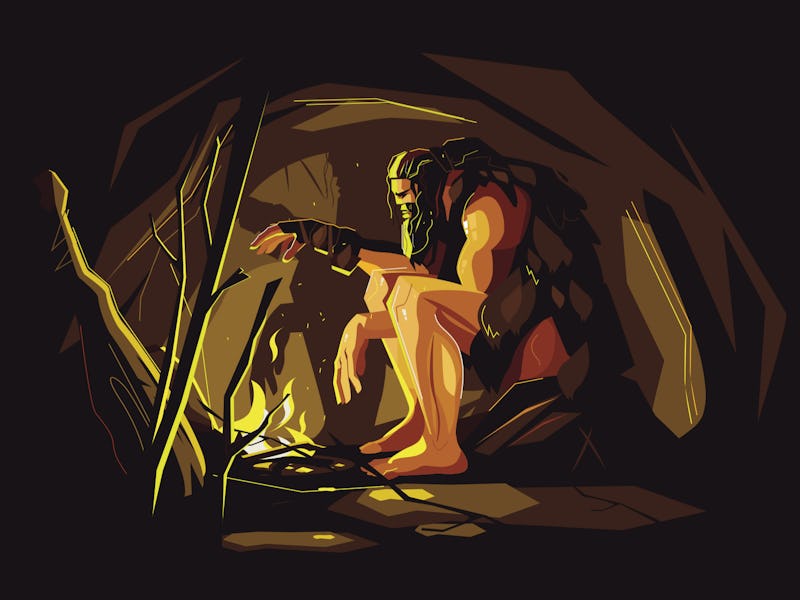Not guilty: Humans off the hook for Neanderthals' demise
Finally, an extinction that we aren't responsible for.

Some 40,000 years ago, the world lost a species of ancient human: the Neanderthals. Their extinction happened not too long after Homo sapiens is thought to have arrived in Europe — the Neanderthals’ stomping ground. When the Neanderthals started to disappear, other ancient humans took over their territories, and our own species thrived.
That’s some heavy circumstantial evidence for a commonly-held theory of what, exactly, killed the Neanderthals. Our own species may have flourished in their place by outsmarting and outnumbering them, driving them to extinction. That story assumes that Neanderthals and humans were in strong competition over resources, at least when they weren’t having sex with each other.
It’s not the only theory of what killed the Neanderthals. It’s been proposed that environmental disasters, illness, or inbreeding killed them off. But the ‘humans did it’ explanation is by far the most popular.
Comparison of modern human and Neanderthal skulls.
Did humans kill the Neanderthals?
Krist Vaesen, associate professor at the Eindhoven University of Technology, tells Inverse that he and his team were dissatisfied with the standard explanations of Neanderthal extinction. As researchers come to realize how much Neanderthals were like us — they created art, they used inventions — “the more enigmatic their disappearance,” he says. There had to be another explanation as to why they went extinct.
"The mere fact that their population was small could have resulted in their extinction."
Vaesen and his team used population modeling to test how various elements would have affected population numbers without the external factor of modern human competition. The results were published this week in the journal PLOS ONE.
Far from humans being 100 percent to blame, the internal dynamics of the Neanderthal population might have been enough for Neanderthals to disappear, the study suggests.
“The mere fact that their population was small, could have resulted in their extinction,” Vaesen says.
To find out what factors — other than us — were at play, the researchers simulated the effects of inbreeding, annual random demographic fluctuations in births, deaths, and the sex ratio, as well as the interaction between reproduction and species fitness on population size (known as the Allee effect).
Population dynamics
The model populations were designed to see if any of these factors could induce extinction over a 10,000-year period, and incorporated Neanderthal populations of various sizes, ranging from 50 individuals to 5,000 individuals.
In large populations, reproduction rates can drop because the population is exceeding the carrying capacity of their habitat. In small populations — like the Neanderthals, who maxed out at around 70,000 individuals inhabiting an area stretching from the Black Sea to the Atlantic coast — reproduction and fitness rates appeared to drop for several reasons. These include not being able to find a suitable mate, and too few individuals to carry out cooperative tasks like hunting and childcare.
A model of a Neanderthal at Britain's Natural History Museum.
Neither demographic fluctuations nor inbreeding alone are likely to have caused extinction, but either of these factors in combination with Allee effects could have created the perfect storm. If 25 percent fewer Neanderthal women gave birth within a year, that would have caused groups of up to 1,000 to die off, the model shows. If all three of these factors were in play, then that could have caused extinction across Neanderthal groups within 10,000 years, the study suggests.
That’s not to say that our species’ meeting with Neanderthals didn’t have any effect on their demise. But we didn’t contribute to their extinction by outcompeting them. Interbreeding between our species and theirs may have resulted in fewer Neanderthal-only mating pairs, and it’s possible that the influx of modern humans interrupted Neanderthals’ migratory activity. But, all in all, the presence of Homo sapiens in Europe may have just sped up the inevitable, not caused it, the findings suggest.
This is a null hypothesis, says Vaesen. No one can ever say for sure — with the evidence available — what caused the Neanderthals to disappear. rather, the study is a hint that Neanderthals’ “downfall is attributed to random events, rather than to some external factors,”
“It is,” Vaesen says, “the most parsimonious explanation for the downfall.”
Abstract:
The replacement of Neanderthals by Anatomically Modern Humans has typically been attributed to environmental pressure or a superiority of modern humans with respect to competition for resources. Here we present two independent models that suggest that no such heatedly debated factors might be needed to account for the demise of Neanderthals. Starting from the observation that Neanderthal populations already were small before the arrival of modern humans, the models implement three factors that conservation biology identifies as critical for a small population’s persistence, namely inbreeding, Allee effects and stochasticity. Our results indicate that the disappearance of Neanderthals might have resided in the smallness of their population(s) alone: even if they had been identical to modern humans in their cognitive, social and cultural traits, and even in the absence of inter-specific competition, Neanderthals faced a considerable risk of extinction. Furthermore, we suggest that if modern humans contributed to the demise of Neanderthals, that contribution might have had nothing to do with resource competition, but rather with how the incoming populations geographically restructured the resident populations, in a way that reinforced Allee effects, and the effects of inbreeding and stochasticity.